

Average Yacht Prices | 40, 50, 60, 70, 100 feet + Helpful Examples
How much do yachts cost? Let’s look at yacht prices per size.
SELECT SIZE ⇩
Note: We will look at yachts that are a few years old. Very few people buy brand-new yachts as the price comes down a lot after only a few years.
How much is a small yacht? Let’s start at 40 feet length.
40 Foot Yacht Cost
A 40-foot yacht can be found used for around $200,000 and new models can cost as much as a million dollars. There are always lots of used yachts for sale around 40 feet in length, which makes them more attractive to first-time buyers.
Technically, a yacht begins at 23 feet. However, yachts that size will more often be referred to as boats.
A 40-foot yacht is a great option for looking for relative simplicity and plenty of comfort and capability. This size is great for day trips in the Caribbean dedicated to speed boating or simple cruising.
The size remains manageable, but the vessel can be updated with extra living spaces and amenities as desired, with a more affordable price than larger options.
The maintenance prices will remain lower as well.
Make sure you are considering the age of your yacht. Even if it is on the smaller end, it will be more expensive if it is new and custom-built to your wants.
Even if you think a 40-foot yacht is the cheapest option, these small factors make for a sliding price scale.
You might find that a smaller, new, custom yacht is more expensive than an older, simpler, larger yacht. One benefit of an older yacht is that it should have the improvements and equipment that make it comfortable to operate and will not have those additional costs.
For sailboat prices specifically, check out this article .
Our Pick: Viking 42 Convertible: Cruise and Fish (2014)
Price: $895,000

- Cushioned seats
- Underwater lights
- Flybridge fiberglass hard-top
- Recent engine and service
- Joystick control
- Cockpit shade with poles, freezer, and step-up box
- Custom chairs
- Coach roof overhang to provide shade
- home theater setup
- Freshwater wash area
- Cockpit freezer and drink box
- Forward-facing viewing windows in deckhouse
Here’s a great example of a yacht with differing ages and year models. It has twin diesel engines, 600 hp each, and cruise at 35 mph (pretty fast!).
Yacht Price Examples for Three Other 40-50 Foot
- 42-foot Grand Banks 42 Classic; trawler-cruiser style yacht; twin diesel, 350 hp each, cruising speed is 13 mph. Price: $370,000 for 2004; $124,500 for 1986; older ones for less
- 45-foot Sea Ray 450 Sundancer or Sedan Bridge; single or twin diesel, about 1,000 hp total; cruising speed about 26 mph Price: $472,000 for 2012 twin-engine
- 41-foot Back Cove Downeast; single diesel 715 hp; cruising speed is 26 mph Price: $619,000 for 2016
50 Foot Yacht Cost
50-foot yachts are normally owner-operated, so you wouldn’t need to pay for a crew. Now we are around the size of 2-bedroom yachts.
They can provide more living space giving the owner flexibility for more guests and making it a more permanent residential option. With more space comes the opportunity to install more amenities as well.
The biggest difference between the 40-foot vessel and the 50-foot is the accommodations.
Expect three-cabin layouts, which give plenty of space for rest. The opportunity to create guest rooms, owners’ suite, and entertainment spaces are better with these yachts.
Our Pick: Hatteras GT54 Convertible Sportfish

The price for the 2017 model of this used yacht starts at $2,249,000.
This yacht is 53′ 10″ long and weighs 75,000 pounds! It has twin diesel engines, 1,300 hp each, cruising speed of 35 mph.
It has a 1200-gallon fuel capacity with three staterooms. It sleeps up to 6 people, so it is perfect for entertaining without being so large to the point where maintenance becomes very difficult. It is known for its great propulsion rates and is very smooth and agile.
It specializes as a fishing boat but allows plenty of room for guests. In addition to the three staterooms, it has a large salon deck, a spacious galley, and plenty of indoor and outdoor seating.
Yacht Price Examples for Two Other 50 Foot
- 51-foot Azimut Magellano 50; express cruiser; twin diesel engines, 425 hp each, cruising speed 16 mph Price: $670,760 for 2013
- 52-foot Carver C52 Command Bridge; twin diesel engines, 600 hp each; cruising speed 18- 26 mph Price: $1,149,000 for 2017; $1,750,00 for 2021 with bow thrusters, gyro-stabilizer
How much is a large yacht? Let’s step up to 60 foot.
60 Foot Yacht Cost
Now we’re looking at 2-bedroom yacht prices. A yacht in this range approaches the upper end of the owner/operator criteria.
This means that owners need to decide whether they can handle this size yacht on their own or if they need to hire outside help from a crew.
If you’re thinking of buying a boat this size, the cost may not be an issue, but understand that adding crew members adds substantial extra expenses! Crew salaries start at around $3K /mth for junior members and $10K for captains and experienced crew members.
This size is great for longer travels beyond day trips and adds more and more space for extra amenities. Hosting guests becomes easier.
Here are some examples:
Our Pick: Hatteras M60

The average base price for this model is around $2,995,000.
The Hatteras M60 is great for someone who wants the luxury of a larger yacht but still wants to be an owner-operator. The deck’s layout below and above is spacious, with a large salon and a full master suite. It can be customized to order with hardwood floors or specific carpeting and amenities like TVs, a bar, a full kitchen, etc. It is a motor yacht, meant for pleasure cruising.
It has twin diesel engines, 1135 hp each; cruising speed is 28 mph.
Yacht Price Examples for Two Other 60 Foot
- 64-foot Schaefer 640; express cruiser; twin diesel engines, 625 hp each; cruising speed 25 mph Price: $1,299,000 for 2017
- 60-foot Sunreef 62 Sailing Catamaran; twin diesel engines 110 hp each; cruising speed 10 mph Price: $990,000 for 2009
70 Foot Yacht Cost
We’re now looking at 3-bedroom yachts. Once you reach this size yacht, it is almost guaranteed you will need a crew to help operate it. A crewed yacht is very different from an owner-operated yacht.
This is just shy of the superyacht category, so if you settle on this size, know you are almost there!
As previously mentioned, as the yacht size gets larger, so do the number of factors that make the purchase more layered and complex.
When yachts reach this size, the interior layout begins to change more drastically. They often have a spacious main deck perfect for dining and entertaining guests, whereas below, the yacht would likely have four or more cabins and crew quarters.
With more rooms comes more cost and more opportunity to customize the space to make it your own.
Here are some great options for this size:
Our Pick: Hatteras GT70 Convertible Sportfish

The 2017 GT70 model runs around $4,500,000, but keep in mind the extra costs of maintenance, furnishing, and a cabin crew to help it run. It’s great for a long vacation and far-away destinations.
The GT70 convertible sportfish is known for its speed and agility, and high propulsion power. It has twin diesel engines, 1900 hp each; cruising speed over 30 mph.
It is 70′ 6″ with 2,140-gallon fuel capacity. The inside is lavish, with a galley, a huge salon, and five staterooms.
Yacht Price Examples for Two Other 70 Foot
- 75-foot Hatteras Motor Yacht; sport cruiser; twin diesel, 1800 hp each; cruising speed 28 mph. Price: $4,375,000 for 2017
- 74-foot Ocean Alexander Motoryacht; twin diesel, 1150 hp each; cruising speed 24 mph. Price: $1,895,000 for 2011
100 Foot Yacht Costs (and up):
You are officially in the superyacht range.
These yachts come in all styles and shapes, allowing for cruising along coastlines or focusing on watercraft and speed boating.
Since this is likely the peak size boat for practical use, you can expect a lot of additional costs for hiring a crew, maintenance, docking, as well as stocking your boat full of amenities.
You’re likely to spend the bulk of your costs furnishing this size boat as bigger yachts typically are sold without furniture. The previous owner will want to hold on to designer furniture and other expensive interior.
Check out these great examples of 100-foot yachts .
Our Pick: 143′ 04″ Virtus 44

This model cost around $20,189,000.
This mega yacht is anyone’s dream.
It is home to a fully integrated beach club with room for a pool deck, floor-to-ceiling windows in the main salon, a hot tub on the top deck, five staterooms, an 8-person crew, and room to sleep ten guests.
It has room for water toys and other gadgets, with a layout that keeps them purposefully hidden from the outside world. It has a 12-knot cruising speed and 16-knot max speed,
Other 100+ Feet Yachts Price Examples
- 98′ 5″ AB 100 Price: $8,843,260 for 2018
- 161′ 04″ Acico Nassima Price: $17,933,000 for 2012
How Much is Yacht Insurance?
Insurance on a yacht is around 1% of the purchase price per year. It can go higher if you have lots of expensive designer furniture. This can add up over the years. It’s often cheaper to insure a sailing yacht but the price range is still within the 0.7-1.3%.
What Other Expenses Do Yacht Owners Face?
Harbor fees is another expense for yacht owners. It’s also a yearly fee that varies but as a rule of thumb, you can expect to pay around $100 per foot per year, depending on how popular the marina is. You will also have to be on a waitlist if you want a good location.
How Much Does a Luxury Yacht Cost?
A super yacht fall under the category of “luxury yachts” or “mega-yachts”.
The world’s largest private vessel belongs to the Prime Minister of the United Arab Emirates, Khalifa bin Zayed Al Nahyan’s Azzam. It is 590 feet long and costs $600 million to build!
It is outliers like these that increase the price average for yacht owners, perhaps scaring potential owners when they start their research.
As a luxury yacht price guide, however, we need to look at averages.
Currently, the average superyacht costs $275 million. This does not even account for maintenance costs, either.
Superyachts are large and luxurious, needing a professional crew to help them run. They are designed to emphasize comfort, speed, and longer expeditions – depending on the yacht builders.
They might have:
- swimming pools,
- water toys,
- diving and fishing poles,
- fully furnished rooms,
- helicopter landing pads,
- and smaller support vessels
Just to name a few amenities. They are truly the epitome of the elite.
What Size Boat is Considered a Yacht?
The normal yacht length starts at around 23 feet, and can extend hundreds of feet. If the boat meets 23 feet, it can be considered a yacht.
A boat does not need luxury features to be considered a yacht.
It can be minimal and stripped of the “extra” stuff to fall into the yacht category, so long as it meets the size and length criteria.
11 Things to Consider Before You Purchase
When making this purchase, the yacht size you buy needs to reflect what you hope to get out of the vessel.
Some important questions to ask yourself before you buy are:
- What does your perfect day on the water look like?
- How long will your average day on the water be?
- Will it be more boating/watercraft focused or long cruise focused?
- Will you use the yacht for fishing?
- Will you be on the yacht every day of the week or just on weekends?
- How many people do you hope to fit on the yacht?
- Do you plan to stay on the yacht overnight?
- Where will you dock the yacht?
- How much boating experience do you have?
- How fast do you want the yacht to go?
- How important is it to have extra amenities like furnished rooms, water toys, electronics, etc.?
These questions will guide you to understand the size you really need and will be able to realistically maintain versus what your most ideal yacht would look like.
When Do You Need a Full-Time Crew?
At length over 50 or 60 feet, you may need a full-time captain or crew.
A full-time crew person will be needed to keep all the varnished woodwork looking good and all the little things maintained.
Sometimes, you must be honest with yourself about what you want and what you actually need. Be self-aware about your abilities (or lack thereof) in taking care of a specific size yacht.
If you don’t know much about boats and navigation, you will need more help to use your vessel.
Hopefully, this comprehensive guide gives you a good starting point as you begin your yacht price research process.
Important Things to Consider As Well
Although there are many factors to consider when understanding a yacht’s prices, it is an exciting purchase nonetheless and should be enjoyed as much as possible.
At the end of your research, you’ll be the owner of a beautiful yacht you can use for leisure, cruising, sports craft, fishing, or all of the above.
Although this article is a good starting point, we would also recommend getting in touch with a yacht broker who can help you find your best fit , model, year, and the price is given your personal budget.
They are great sources of knowledge in addition to personal research.
Make sure you are as patient as possible in this process to make sure you are covering all your bases, but most importantly, enjoy the process!
Here’s How Much Yachts Cost on Average:
Yachts start around $300,000 for smaller 40-foot models and can go as high as several hundred million dollars for superyachts.
These are the main contributing factors to the price of a yacht:
- The size of the yacht
- The age of the yacht
- The brand and type of yacht
In general, the larger the yacht is, the more important the quality of the build becomes.
Also, potential owners need to understand the cruising speed and propulsion of different yachts.
The yacht type is also broken down into two categories:
- Mediterranean Style Open style expresses yacht with maximum space for sun, little-to-no shade on the deck.
- Hard-top express Semi-enclosed or fully-enclosed space on deck for the operator
- Flybridge yachts
An express yacht is often referred to interchangeably as an express cruiser or sports cruiser .
It has a single deck above the hull with a living space below.
They are much sleeker, too.
A flybridge yacht is often referred to as a sedan bridge or sport bridge, and it is typically used for fishing. It has additional space above the main deck.
Since the flybridge area has more space on the second deck, the main deck is normally made up of enclosed spaces and rooms.
It can have an open-air layout but can also have a hard-top.
Click to share...
- Articles and Guides
How Much Does a Yacht Cost?
December 11, 2024 by samantha wilson.
We hear questions like “What’s the cost of a yacht?” on a regular basis, and it’s a difficult to answer the question with any precision because the cost of yachts covers a wide range. Much the same as with houses, the prices vary significantly depending on size, style, age, and finish—even location. The price difference for yachts can in fact stretch to millions of dollars when we consider they range from 30-footers all the way up to 300-foot superyachts. But we’re getting ahead of ourselves—first, let’s tackle the more fundamental question, “What is a yacht?”
What Classifies as a Yacht?
To begin with, yachts can be sailing yachts or motor-powered yachts. But it’s the size of the vessel that gives it the true classification of yacht status. Many in the industry classify a boat as a “yacht” from 40 feet up to 70 feet, although there are others who will include any vessels over 30 feet. Over the 70-foot mark, we’re getting close to superyacht territory, and above 165 feet, they’re megayachts. However, there is no hard and fast rule, and what may be a yacht to one person might not be to another, with a 20-foot sailing boat classifying as a yacht if the owner feels it is one.
While size is the main determining factor in labelling boats as yachts, amenities aboard also play a role. For example, yachts usually have cabins and heads below allowing for overnight stays, as well as a galley, and plenty of deck space for leisure.
The term “yacht” has become synonymous with luxury, especially with the boom in superyachts making international news. But a yacht doesn’t have to be luxurious, and everyone will see luxury differently. A beautiful 30-foot trawler yacht might be luxurious to one person, but Jeff Bezos and his brand new $500 million sailing yacht Koru would probably see it differently.
The Cost of Buying a Yacht
Looking at an average price across all yachts isn’t a very helpful figure, because sizes of yachts vary from 30 feet to 300 feet or more. And that doesn’t take into account whether a boat is new or used. Broadly speaking, in the United States you can often buy a small, used sailing yacht for £12,000 or $15,000, but you may well find that figure to be at least 10 times higher for a small, new motor yacht. And it can almost go without saying, but a larger, new sailing or motor yacht can cost hundreds of thousands of dollars, or even a million or two. As for superyachts of 100 or 200 feet in length, depending on age, you’ll commonly see prices of $10 million to $25 million.
The Cost of Different Types of Yacht
When we talk about yachts and their values, we usually refer mostly to the length of the yacht as that tends to be the identifying factor, but the style, engine size, and finish also play a huge role in determining how much they cost. Here we take a look at the average price differences between new and used yachts in the United States at varying sizes.
How much does a small yacht cost? (25 to 40 feet)
A small power yacht around 40 feet, such as a cabin cruiser, might be considered an entry-level yacht, yet it’s a big step up from much smaller day boats. Vessels this size likely have cabins and heads and a small galley, and they offer the chance to spend weekends onboard. Prices will be hugely variable depending on whether the yacht is used or new, and the model, finish, and horsepower. Almost new (one or two year old) yachts around 40 feet can cost anywhere from $350,000 to over $1 million, but the price for older models falls dramatically. To give you a sense of the market for used yachts of this size in the United States, the average price for those from 36 feet to 45 feet is barely over $200,000.
When we’re looking at smaller yachts around 25 to 30 feet, these are generally considered day or overnight cruisers and some will have a small cabin and galley. Sports cruisers between 25 and 30 feet that may range from $70,000 for a good-condition used model to well over $250,000 for a brand new one. See our guide to the different types of boats for a better understanding of what is available and what might be right for you.
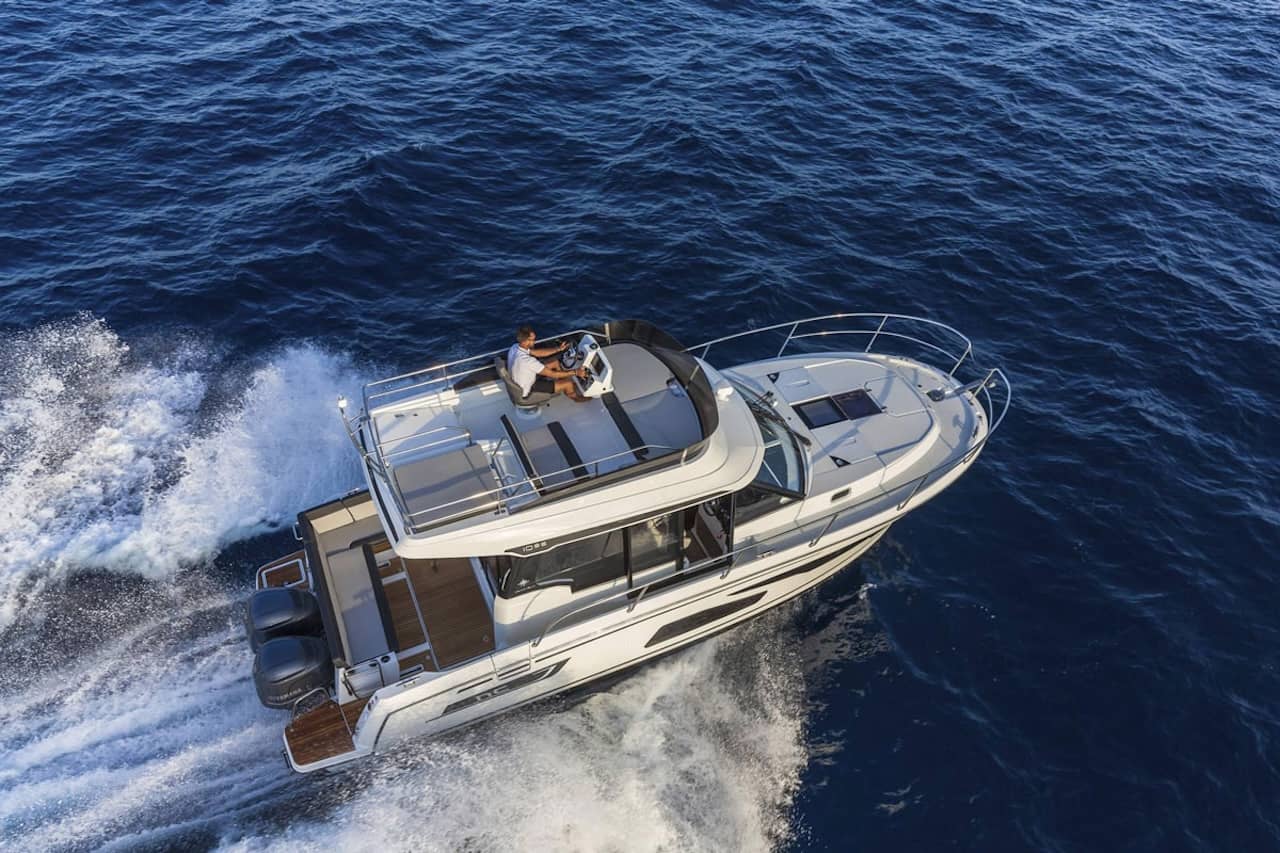
Sports cruisers measuring 25 to 30 feet can cost from $70,000 for a well-maintained used model to over $250,000 for a brand-new one. Jeanneau photo
How much does a medium-sized yacht cost? (40 to 70 feet)
Mid-sized yachts that fall within the 40 to 70 feet category vary in price from around $150,000 to over $5 million, but that figure depends on the size, model, finish, engines, and extras, as well as whether it’s a brand new boat or used. According to the Boats Group Market Index of 2022, the average yacht price in the United States was at the lower end of this range—$154,357 from 43,915 boats sold, while internationally that figure was $368,206 from 10,670 yachts sold.
Yacht prices in this size range also vary a lot depending on whether they’re new or used. As an example, the base price for a new Viking 58 is $4.1 million, while a used model can be purchased for $3.5 million for a three year old model, or about $600,000 for a 10 year old model. Check out our new and used luxury yachts for sale on Rightboat for more comparisons.
For their higher price tags, mid-sized yachts offer spacious interiors, large decks for lounging and entertaining, as well as features such as swim platforms, alfresco dining areas, comfortable cockpits, and large staterooms for longer times spent at sea. They are equipped with all the comforts of home and designed for entertaining guests and embarking on longer voyages.
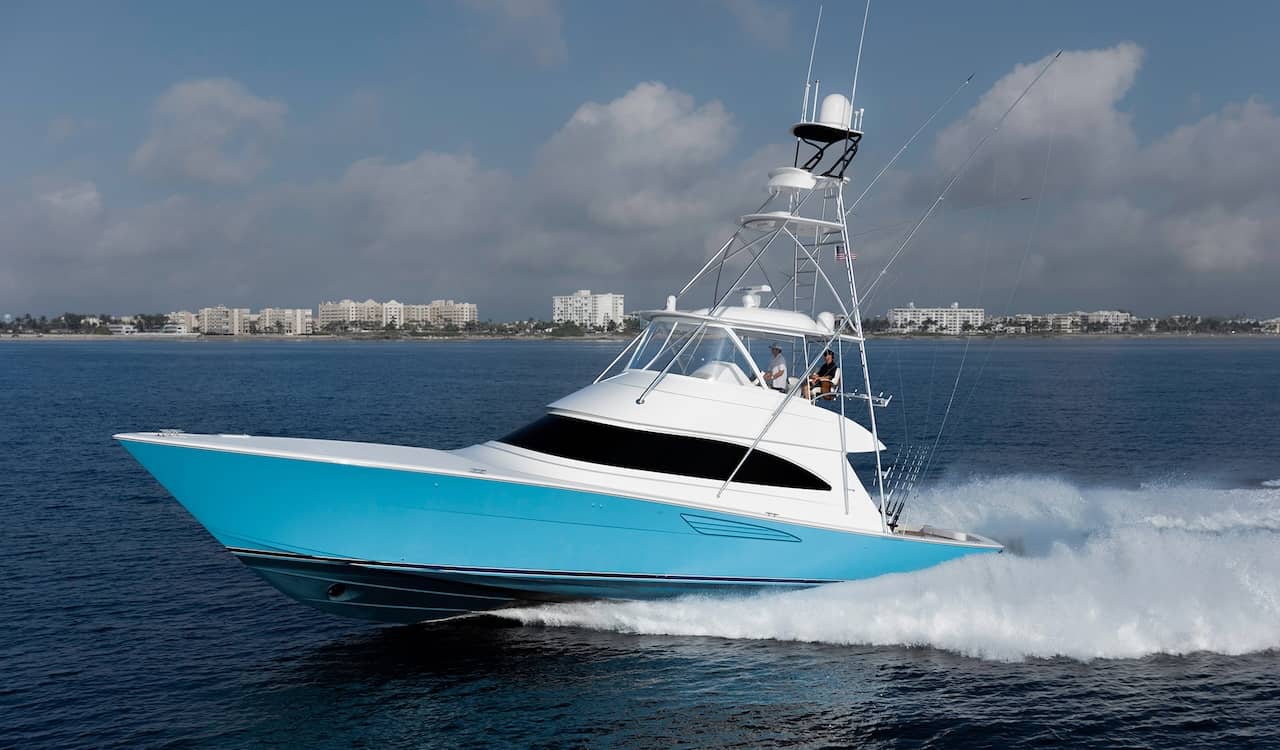
A new Viking 58 costs $4.1 million, while a three-year-old model is $3.5 million, and a ten-year-old model around $600,000. Viking Yachts photo
How much does a sailing yacht cost?
Long before the internal combustion engine was invented, sailing yachts and sailboats of all varieties have been gracing, and crossing, our oceans. While these days we tend to think of yachts as the luxurious motor vessels that far outnumber their sailing counterparts, sailing yachts have their own class. As we’ve seen with motor yachts, the size, age, and finish of a sailing yacht will determine the price tag. Prices might start at $5,000 for 25-foot fixer-upper and run to $5 million or more for a new cruising catamaran. Even more for sailing superyachts. The largest sailing yacht in the world is Sailing Yacht A , which cost an estimated $600 million and measures a staggering 470 feet in length.
While a new 100-foot sailing yacht will typically cost several million dollars, sliding back down the length ladder, smaller yachts will cost progressively less. A 55-foot yacht that is new might retail for $2 million, a two-year-old by another manufacturer might sell for $1 million, and a 20-year-old yacht of the same length might sell for $500,000 or less. At 35 feet, a new sailing yacht may cost only $250,000 to $500,000 depending on brand, a 30-year-old model will often cost one tenth as much. See what you can get for your money with our sailing yachts for sale on Rightboat.
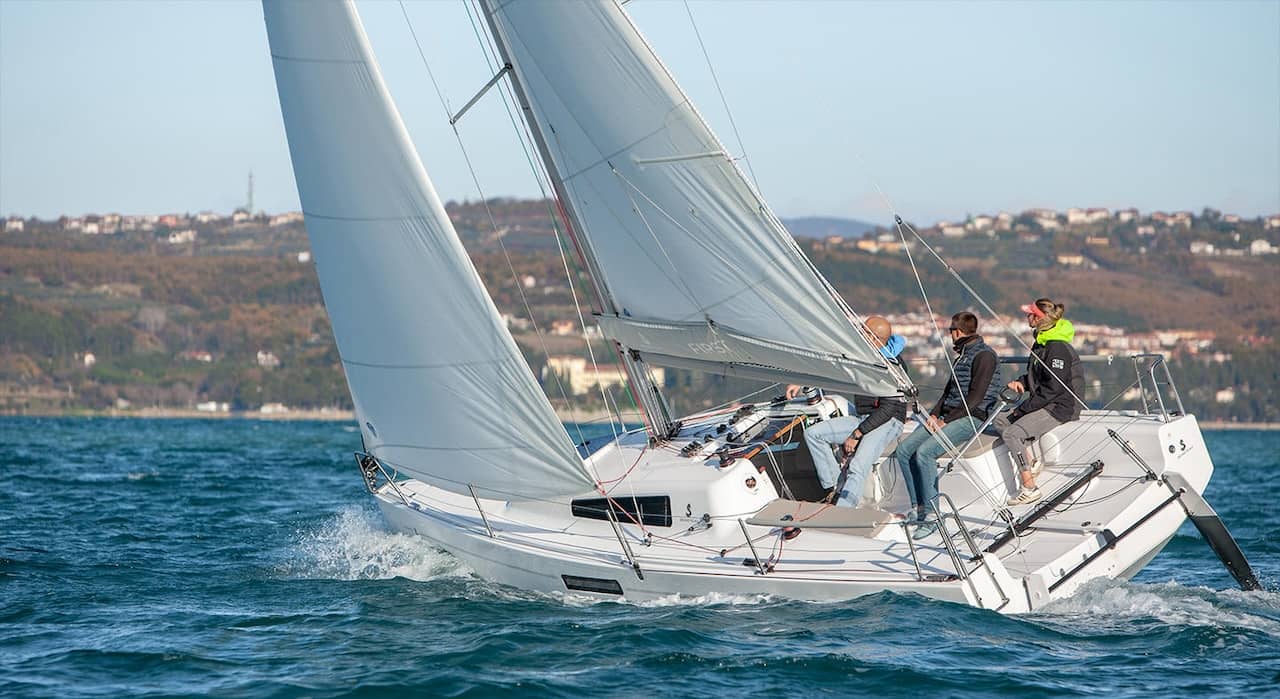
Sailboat prices can start as low as $5,000 for a 25-foot fixer-upper and go up from there. Beneteau photo
How much does a luxury yacht or superyacht cost?
Superyachts are some of the most luxurious vessels in the world and it comes as no surprise that they don’t come cheap. Anything above 78 feet is generally accepted to be a superyacht, and they can range up to 165 feet beyond which some in the industry refer to them as megayachts. This term is still debated (see Mega Yacht vs Superyacht ).
Superyachts require a full time crew to run them, which adds to the overall cost of running such a large vessel. So how much does a superyacht cost? The costs vary widely, with some estimates of up to $1 million per foot of length to build a new top-of-the-line custom superyacht. Used superyachts will cost less than a new build, and you can buy a 10 year old, 80- to 90-foot superyacht for around $2.5 million. Models that are less than five years old will be closer to the $4 million mark, while a brand new one will cost around $9 million. Check out our listings for superyachts for sale all across the world.
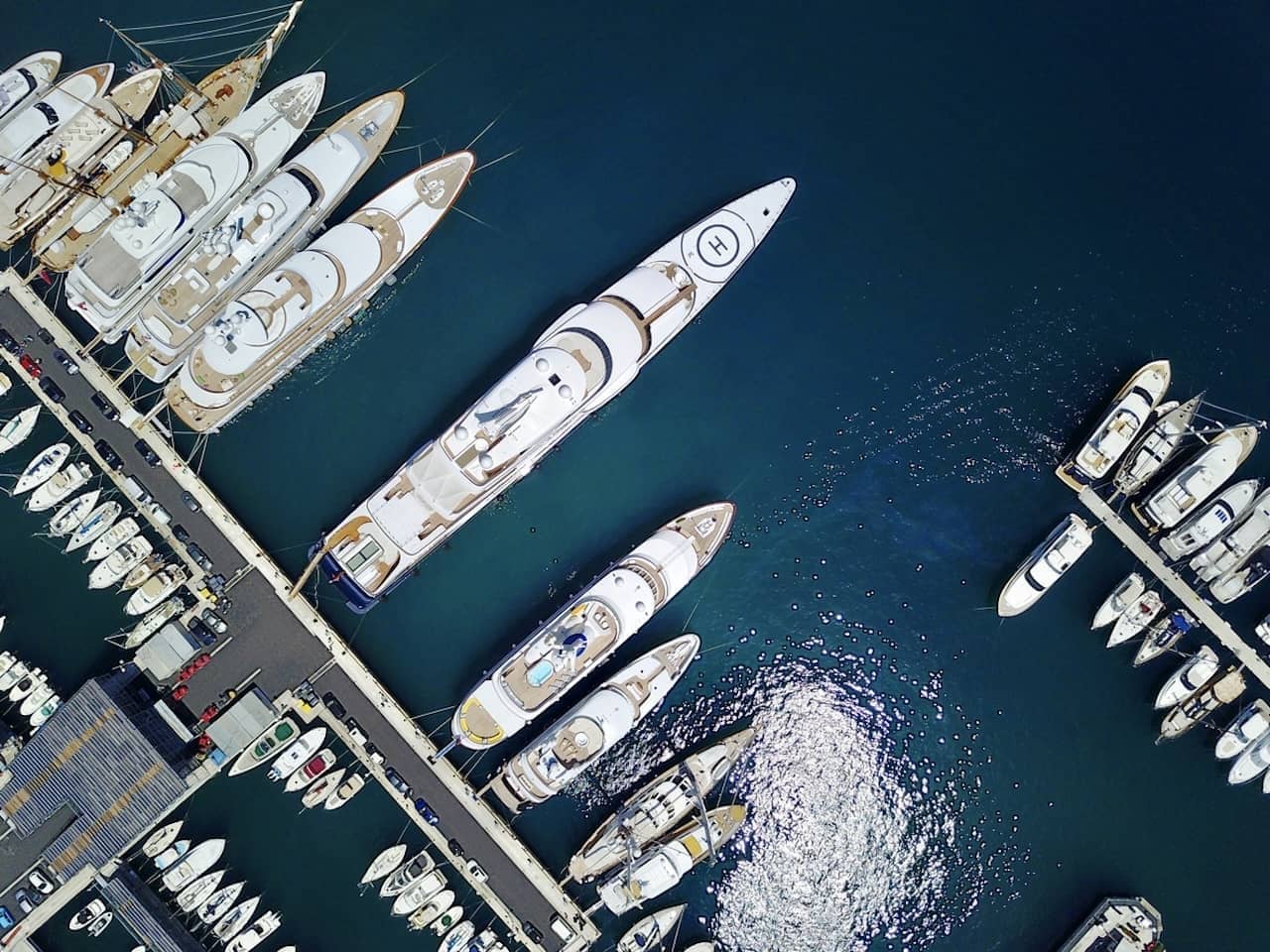
The costs vary widely, with some estimates of up to $1 million per foot of length to build a new top-of-the-line custom superyacht.
How much does a megayacht cost?
When we reach megayacht status, the prices skyrocket along with the length of the vessels. While the term megayacht is debated, these days it tends to refer to vessels over 165 feet. The largest megayacht in the world is currently Azzam , which is 590 feet long and cost $600 million to build. Yachts in this class are the most luxurious in the world, and feature huge swimming pools, helicopter pads, huge guest and crew accommodations, beach clubs, and much more. The upkeep of vessels of this size can run to $20 million or more for the crew fees, fuel, mooring fees, insurance, food, and maintenance. If you want to set eyes on the world’s most astounding superyachts and megayachts check out our superyacht travel guide to where you might find them, or use our search to discover megayachts for sale .
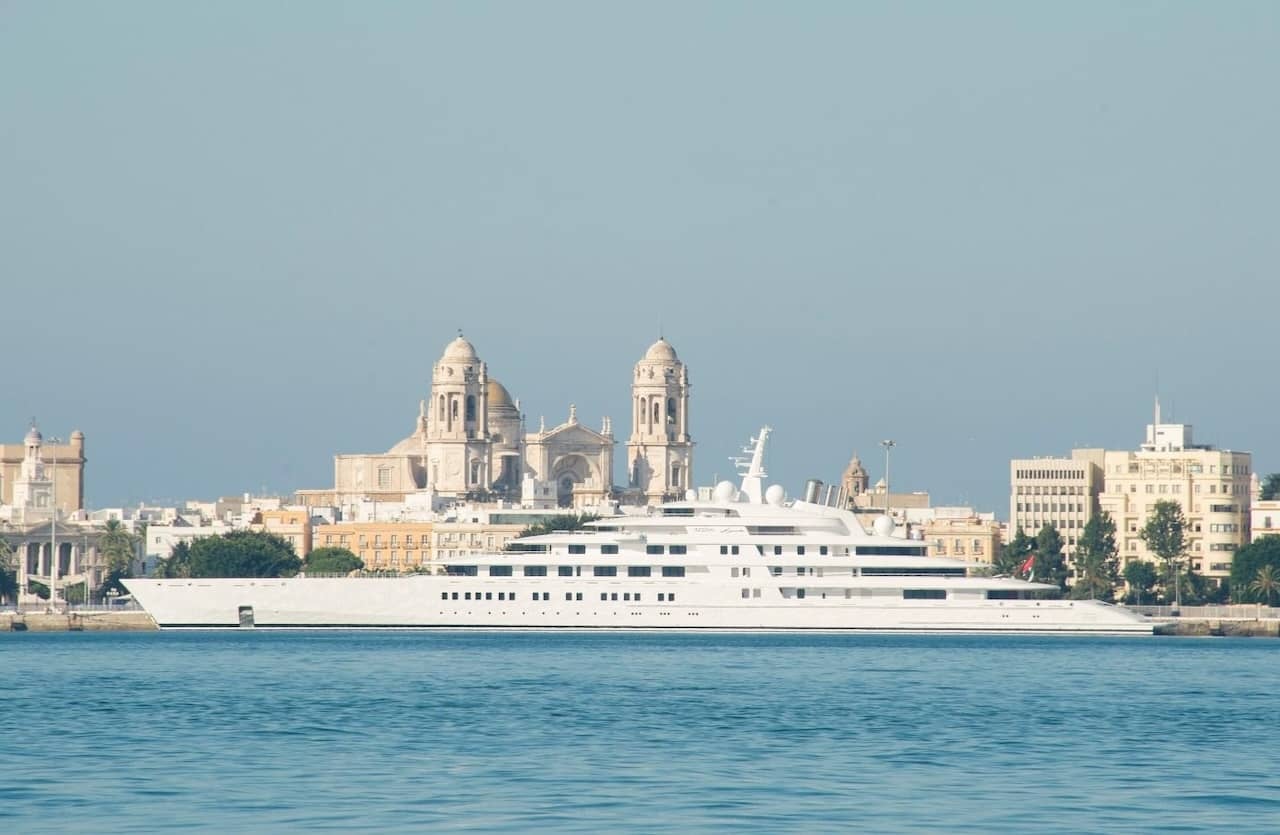
The world's largest megayacht, Azzam is 590 feet long and cost $600 million to build.
New Yacht Costs Versus Used Yacht Costs
While it’s clear that there is an initial purchase price difference between a new and used yacht, there are some other cost considerations to take into account, too. A new yacht will be equipped with the very latest in technology and accessories, as well as having zero wear and tear on the hull, engines, or electronics. They will also come with a manufacturer warranty that offers peace of mind for a set number of years. During this time, new yachts generally cost far less than a used yacht because if anything goes wrong it is covered under the warranty. Having said that, depreciation must be taken into account with a new yacht as they tend to depreciate 10% in the first year and around 6% every year after that.
On the other hand, a used yacht often costs far less to buy and offers great value for money, but it has to be taken into account that there is unlikely to be a warranty included. The upkeep is also likely to be more than it would be for brand new boats as it will require more maintenance and upkeep, perhaps not be as efficient as a newer model, and need upgrades along the way.
The Cost of Owning a Yacht
The cost of owning a yacht is critical to factor in when looking at the initial purchase price, and even if you’re in the market for a small yacht, you’ll need to factor in the annual costs which include:
- Marina fees: These will vary depending on your location and the size of the boat. Expect to pay from $5,000 for a yacht at the smallest end of the scale up to tens of thousands for larger yachts.
- Insurance: As a general rule, you can expect to pay around 0.5% of the value of the boat annually. Check out our guide to boat insurance for more information.
- Maintenance and repairs: As a rough estimation you can expect to spend around 10% of the value of the boat on upkeep each year. This might be lower if it’s a new yacht.
- Gas: This will vary depending on how far you cruise and how large the yacht is.
- Crew: Yachts up to around 80 feet don’t require a crew, but the larger the yacht the more crew it will need. Crew salaries range from $3,200 per month for junior crew to $10,500 per month for captains and chief engineers. In general, a yacht of 80-100 feet in size will require a crew of between two and eight, while yachts between 100 to 200 feet will require between 8 and 20 crew members.
- Depreciation: Brand new boats depreciate the most quickly, with most depreciating by 40 to 50 percent of their initial price over the first 8 to 10 years.
Read more about the Real Costs of Boat Ownership as well as Top Tips to Lower the Costs .
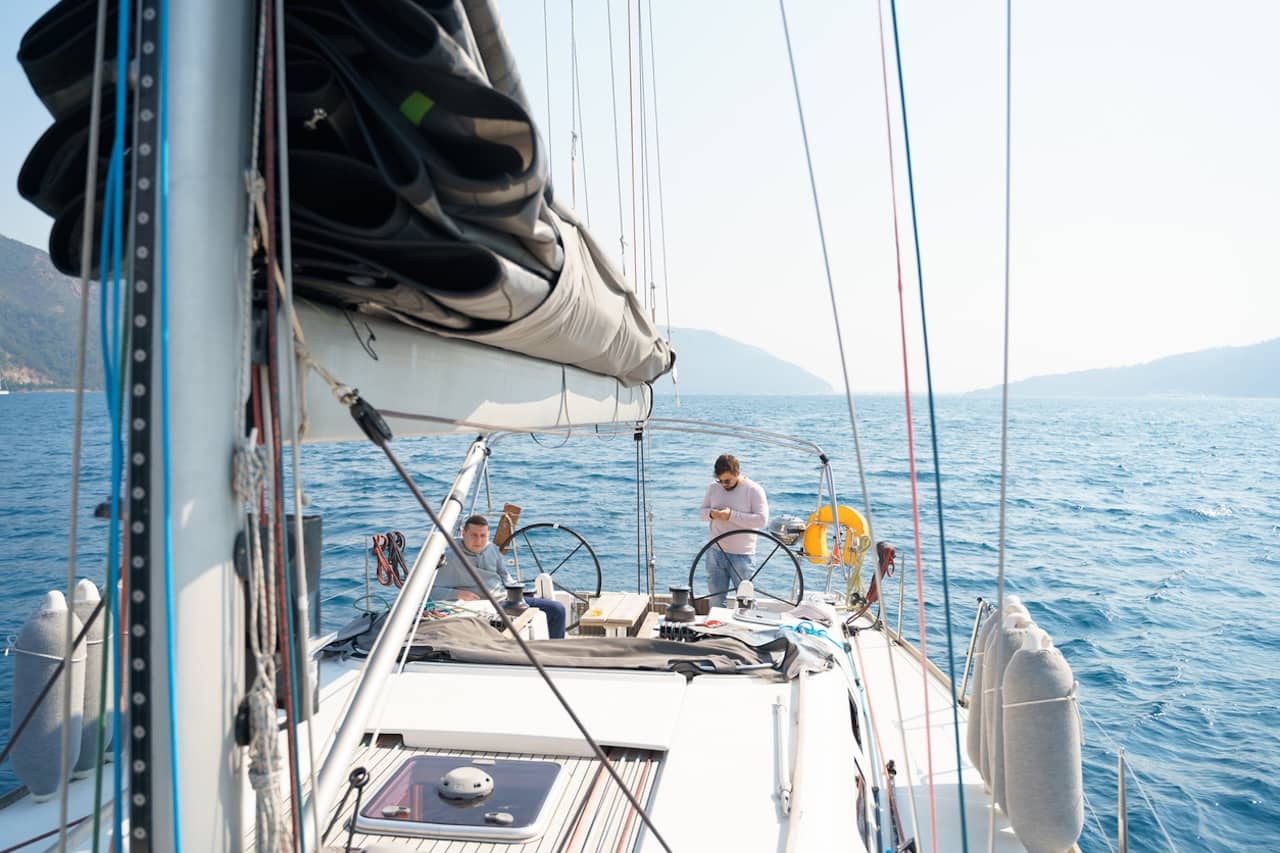
When buying a yacht, it’s crucial to consider ownership costs beyond the purchase price. Even for smaller yachts, annual expenses like marina fees, insurance, maintenance, etc. must be accounted for.
What’s the Difference in Cost Between Buying a Boat and Buying a Yacht?
As we’ve examined above, a yacht can be something different to different people. While a superyacht is indisputably a yacht, a 30-foot sailing yacht may be considered a yacht as well, and the variable purchase prices and running costs will be relative to those sizes and styles. Buying a boat is another broad term, where everything from a Jon boat to a pontoon boat to a 30-foot cabin cruiser can fall within this category. If we take a 20-foot bowrider, for example, we can see how the cost of buying a boat can vary hugely from around $25,000 to $150,000. An average 20 percent per year in running costs is then calculated on top.
Are Yachts a Good Investment?
Anything that brings you joy and gives you and your family time together is a good investment. But looking at it from a purely financial point of view, yachts are a luxury item and they come with their own costs. Like cars, yachts normally don’t appreciate over time but depreciate in price. When you factor in upkeep and running costs, yachts are not likely to make you any money. There are some instances where upgrades to a well-cared-for used yacht that is a highly sought after model can in fact offer a positive return on investment, and some brands of sailboats are a good example of this.
This article was published in July 2023 and updated in December 2024.
Written By: Samantha Wilson
Samantha Wilson has spent her entire life on and around boats, from tiny sailing dinghies all the way up to superyachts. She writes for many boating and yachting publications, top charter agencies, and some of the largest travel businesses in the industry, combining her knowledge and passion of boating, travel and writing to create topical, useful and engaging content.

More from: Samantha Wilson
Related Articles and Guides
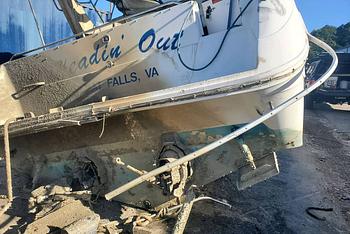
Buying Storm Damaged Boats: Risks & Opportunities
Hurricane damaged boats offer tremendous opportunity to used boat buyers on a budget, but the ris...
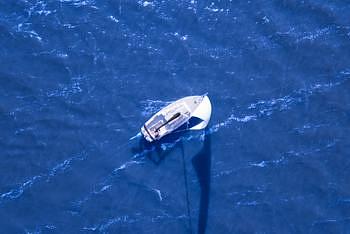
8 First-Time Boat Buyer Mistakes to Avoid
There is no doubt about it that buying a boat is a major purchase, and rarely a process to be rus...

Sea Trial: Costs, Checklist and More
We hear the question, “Do I need a sea trial?” more often that you might think, especially when t...

Boat Survey: What It Is, Who Pays, Do I Need to Spend the Money?
Is a used boat survey worth the time and expense? It’s a valid question that many people ask when...
Cost of Buying & Owning a Small Yacht (Detailed Breakdown)
While some people may prioritize a slower, more eco-friendly, and more hands-on experience that they get from a sailing yacht, others may prefer a faster, more luxurious, but less hands-on experience from operating a motor yacht. However, the tiebreaker comes down to the costs of owning and maintaining them. With that, let's explore how much you'll need to buy and own either a small sailing yacht or a motor yacht, and see which one is more affordable.
A new 30-foot sailing yacht can cost anywhere from $50,000 to $200,000, while a used one in good condition can range from $20,000 to $100,000. On the other hand, a new 30-foot motor yacht can cost between $100,000 and $500,000, while a used one can range from $50,000 to $300,000.
The ongoing costs of owning a yacht include maintenance and repair costs, fuel costs, insurance, docking fees, and more. Let's take a closer look at each of these costs and how they can impact your budget.
- The initial purchase price and ongoing costs of owning a motor yacht are higher than those of a sailing yacht.
- A sailing yacht relies mostly on wind power, while motor yachts require more complex mechanical systems and need more fuel.
- Purchasing older yachts may require more maintenance and repairs.
- Additional initial expenses when purchasing a used yacht include hiring a surveyor, buying bottom paint, looking for upgrades, and purchasing safety equipment.
- Insurance costs for motor yachts are higher due to their faster speeds and increased risk of accidents.
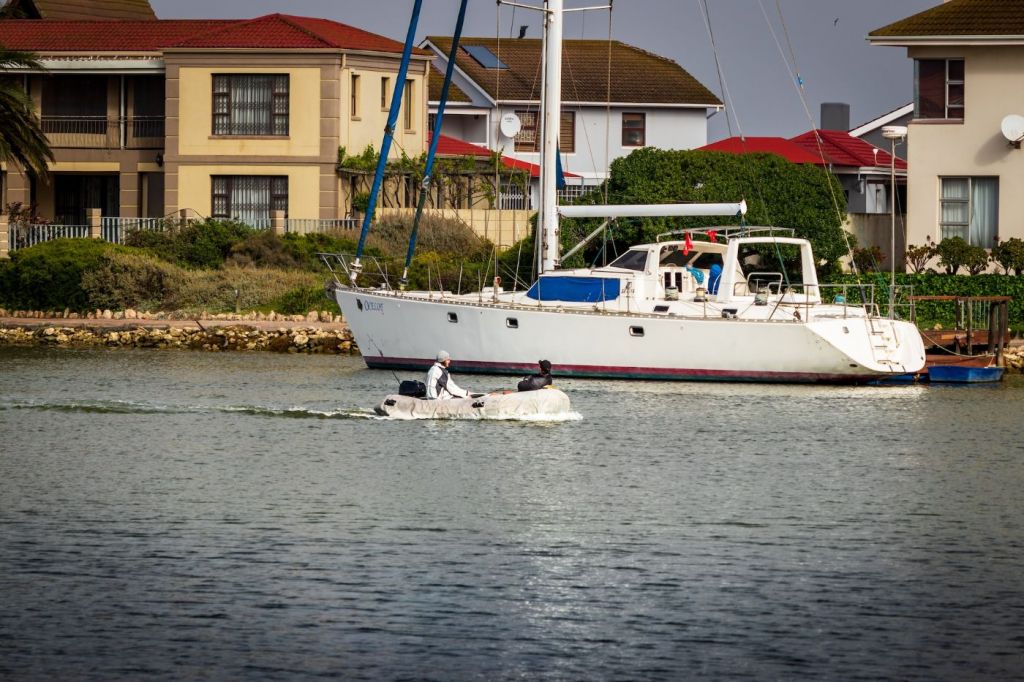
Cost of Buying And Owning A Small Yacht
| $54,750 - $216,750 | $10,300 - $42,400 | |
| $23,500 - $121,500+ | $3,200 - $20,500+ | |
| $108,050 - $540,750 | $9,500 - $57,500 | |
| $55,000 - $328,500 | $12,000 - $28,000 |
1. The average cost of owning a new 30-foot sailing yacht
On average, a small brand-new sailing yacht can cost anywhere from $50,000 to $200,000 or more. This price range typically includes basic features like a cabin, galley, and bathroom, as well as a mast, sails, and rigging. However, the price may not include additional amenities like a generator, air conditioning, or advanced navigation systems.
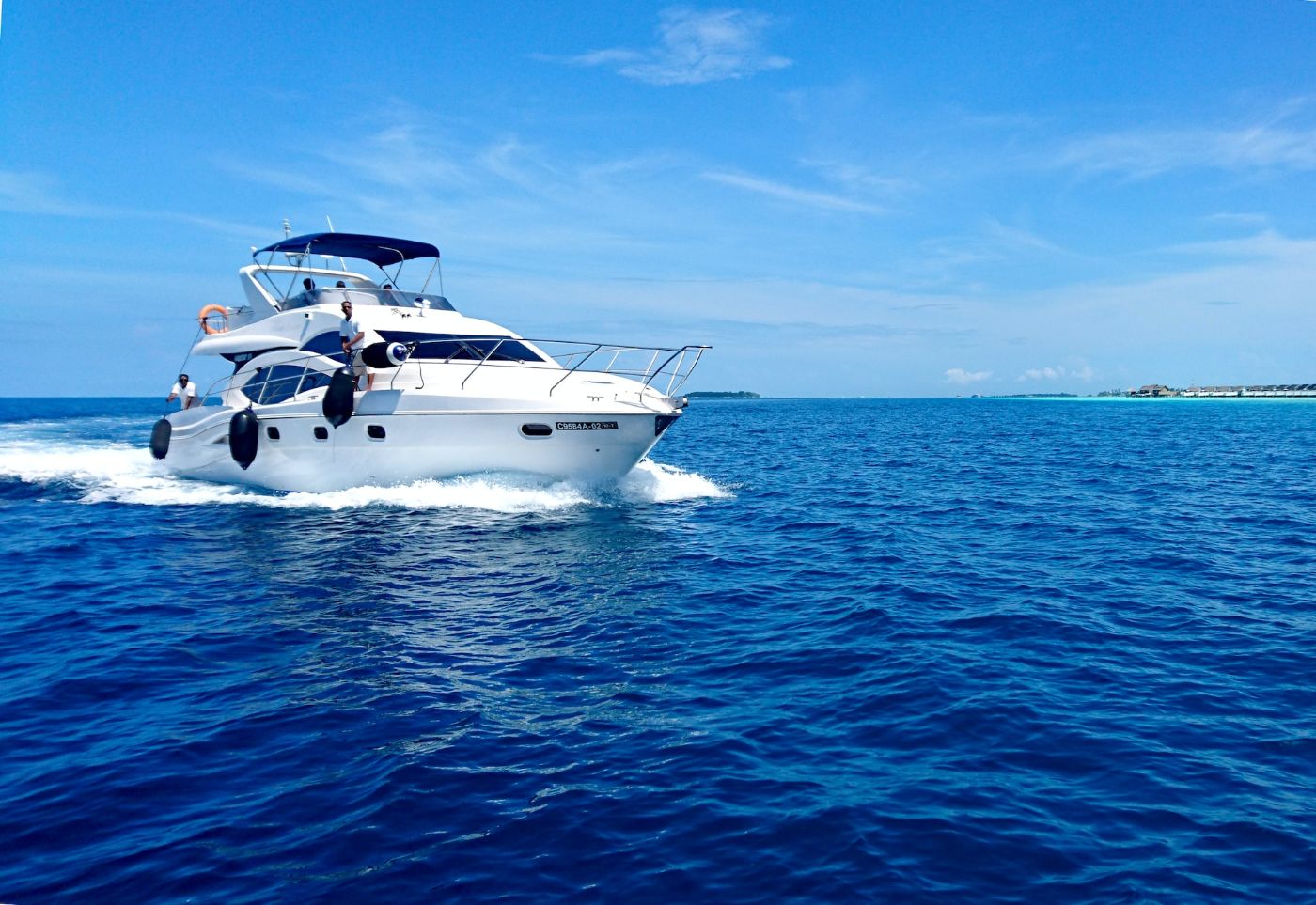
In addition to the initial purchase price, there are also ongoing costs associated with owning a sailing yacht, such as mooring fees, maintenance and repairs, insurance, and fuel costs. These expenses can add up quickly, and you may need to factor them into your budget when considering buying a sailing yacht.
One advantage of owning a sailing yacht is that it can be less expensive to operate than a power yacht, as it relies on wind power rather than fuel. However, sailing yachts also require more maintenance and upkeep, particularly for the rigging and sails .
Initial expenses for a new 30-foot sailing yacht
| $50,000 - $200,000 | |
| $500 | |
| $4,000 - $16,000 | |
| $250 | |
Recurring expenses for a new 30-foot sailing yacht
| $3,600 - $18,000 | |
| $500 - $2,000 | |
| $5,000 - $20,000 | |
| $1,200 - $2,400 | |
2. The average cost of owning a used 30-foot sailing yacht
In general, you can expect to pay anywhere from $20,000 to $100,000 for a used 30-foot sailing yacht. This cost will typically include the purchase price of the boat itself, as well as any necessary upgrades or repairs that may be required.
Once you have purchased the boat, there are a number of ongoing costs associated with owning and maintaining it. These can include mooring or slip fees, insurance, registration and licensing fees, and regular maintenance and repairs.
Although used sailing yachts can be much more affordable than new ones, they may require more maintenance and repairs which can be costly and time-consuming. There may be hidden issues or problems with a used boat that are not immediately apparent, which can lead to unexpected expenses down the line.
Initial expenses for a used 30-foot sailing yacht
| $20,000 - $100,000 | |
| $500 - $1,500 | |
| $1,000 - $3,000 | |
| $500 - $5,000 | |
| $500 - $1,500 | |
| $1,000 - $10,000+ | |
Recurring expenses for a used 30-foot sailing yacht
| $500 - $2,000 | |
| $1,200 - $12,000 | |
| $1,000 - $5,000 | |
| $500 - $1,500 | |
3. The average cost of owning a new 30-foot motor yacht
The cost of a new 30-foot motor yacht can range from around $100,000 to over $500,000, with some luxury models costing even more. Although operating a motor yacht requires less skill and experience than operating a sailing yacht, the initial purchase price and ongoing costs are higher than that of a sailing yacht.
This is because motor yachts require more complex mechanical systems, such as engines, generators, and other electrical and plumbing systems, which can be expensive to install and maintain. They also need more fuel than sailing yachts, which can result in higher ongoing costs for fuel and maintenance.
Initial expenses for a new 30-foot motor yacht
| $100,000 - $500,000 | |
| $7,500 - $37,500 | |
| $50 - $250 | |
| $500 - $2,500 | |
Recurring expenses for a new 30-foot motor yacht
| $3,000 - $25,000 | |
| $1,500 - $7,500 | |
| $2,000 - $10,000 | |
| $3,000 - $15,000 | |
4. The average cost of owning a used 30-foot motor yacht
A used 30-foot motor yacht can cost anywhere from $50,000 to $300,000 or more. However, you'll need to note that older yachts may require more maintenance and repairs, which can add to the overall cost of ownership.
It can be difficult to know how these yachts were used and maintained by their previous owner, which can lead to unexpected issues and repairs. They may also have less fuel-efficient engines, which can lead to higher fuel costs over time.
Initial expenses for a used 30-foot motor yacht
| $50,000 to $300,000 | |
| $500 - $3,000 | |
| $1,000 - $6,000 | |
| $1,500 - $7,500 | |
| $500 - $3,000 | |
| $1,500 - $9,000 | |
Recurring expenses for a used 30-foot motor yacht
| $1,500 - $3,000 | |
| $3,000 - $10,000 | |
| $2,500 - $5,000 | |
| $5,000 - $10,000 | |
Expenses Involved In Buying and Owning A Small Yacht

Initial expenses in buying a small yacht
Boat purchase is not cheap.
The first cost you'll encounter when buying a yacht is the purchase price which can range from tens of thousands of dollars to millions of dollars. When setting a budget for your yacht purchase, try to consider not only the purchase price but also the ongoing costs of ownership.
You need to register your yacht
Before you can legally operate your small yacht, you need to register it with the relevant authorities. The registration process depends on your location and the size of your yacht. In Oregon, for example, all boats with motors must be titled and registered with the Oregon State Marine Board. The registration fee is based on the length of the vessel.
To register your yacht, you will need to provide proof of ownership, such as a bill of sale, and complete the necessary paperwork. You may also need to provide proof of insurance and pay any applicable taxes.
Factor in payment for taxes
Each state has its own tax laws, and some states may have additional taxes or fees that apply to yacht owners. In Florida, there is a 6% sales tax on boats, while in Texas, the sales tax is 6.25%. In addition to state taxes, some municipalities or counties may also charge a local sales tax.
Set aside payment for the title fee
The title fee is the cost of transferring the ownership of the yacht from the seller to the buyer. The title fee for a small yacht can range from a few hundred dollars to a few thousand dollars.
Budget for hiring a surveyor
A survey is particularly important when buying a used boat, as it can help uncover any hidden problems that may not be immediately apparent to the buyer. Used boats can have a range of issues, from minor cosmetic defects to serious structural damage, and a survey can help to identify these issues before the sale is completed.
During the survey, the marine surveyor will thoroughly inspect the boat's hull, deck, and superstructure, as well as its mechanical systems, electrical systems, and safety equipment. The surveyor will also test the boat's performance on the water, including its handling, speed, and maneuverability.
After the survey is complete, the surveyor will provide the buyer with a detailed report of their findings, including any defects or deficiencies that were identified. This report can be used by the buyer to negotiate the purchase price or to request that any necessary repairs be made before the sale is completed.
Used small yachts need upgrades and customizations
One of the joys of yacht ownership is the ability to customize your vessel to suit your needs and preferences. Some common upgrades and customizations include:
- Deck hardware: Installing new hardware such as cleats, winches, and blocks can improve the functionality of your yacht, but can also be expensive.
- Communications: Upgrading your communication systems, such as radios and satellite phones, can improve safety and convenience, but can also be costly.
- Vinyls: Adding vinyl graphics to your yacht can be a fun way to personalize your vessel, but can also be expensive.
- Anti-fouling paint: Applying anti-fouling paint to the bottom of your yacht can help prevent the growth of marine organisms, but can also be a recurring expense.
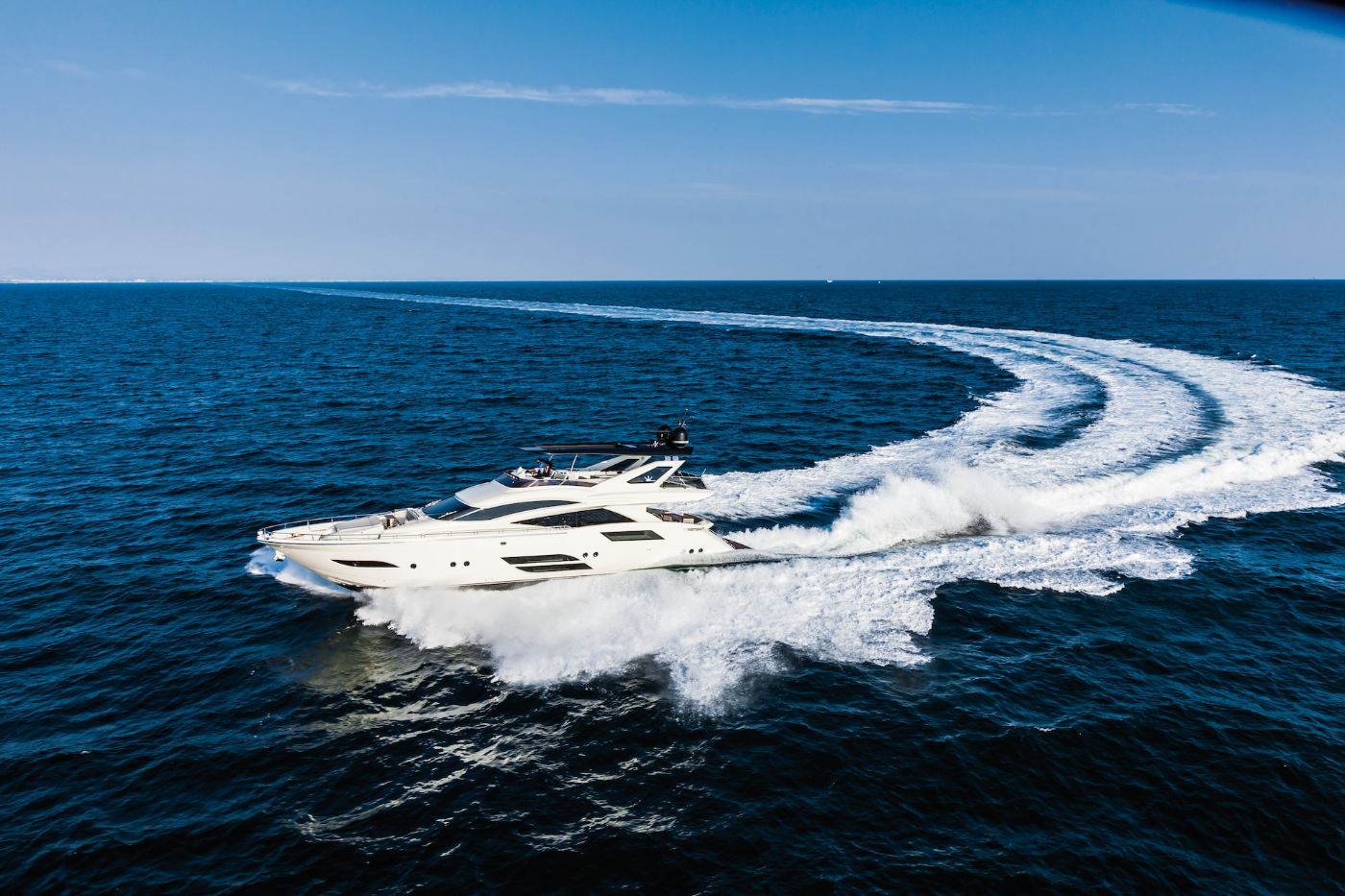

Consider the costs of buying safety equipment
Safety should always be a top priority when operating a yacht. Some essential safety equipment includes:
- Life jackets: Having enough properly fitting life jackets for all passengers is essential for safety.
- Fire extinguishers: Having properly functioning fire extinguishers on board can help prevent a disaster.
- First aid kit: Having a well-stocked first aid kit on board can help in case of injury or illness.
- Emergency signaling devices: Having emergency signaling devices such as flares or an EPIRB can help alert others in case of emergency.
For a more detailed list of the safety equipment you need for your newly purchased small yacht, here's an article you can refer to.
Recurring costs for owning a small yacht
In addition to the initial expenses, there are also ongoing costs associated with owning a yacht such as the following:
Avail an insurance policy for your yacht
Shop around for insurance agencies that specialize in yachts, as there are many clauses and catchphrases that are unfamiliar to the average insurance agent. Insurance companies that specialize in boats often provide surprising discounts for both your own skills and the equipment on your boat.
A specialized insurance policy is generally estimated at between 0.8% and 1.2% of the boat's purchase price per year. It should also cover these 10 basic things included in this article.
Sailing yachts may be more expensive to insure due to their increased risk of damage from weather and other environmental factors, while motor yachts may be more expensive due to their higher speeds and increased risk of accidents.
Keep in mind dockage and mooring fees
You can save money on docking fees by anchoring in free anchorages or finding marinas that offer discounts for long-term stays. Some marinas charge by the foot, while others charge a flat rate. You can try to research different marinas in your area to find the best deal.
In addition to the basic fee, some marinas charge extra for amenities such as electricity, water, and Wi-Fi. You may also want to consider the location of the marina since marinas in popular tourist destinations tend to be more expensive than those in less popular locations.
If you're in California, here are 7 places where you can dock your yacht at the cheapest price.
Consider costs for maintenance and repairs
Maintaining and repairing your small yacht is an important part of yacht ownership. Regular maintenance ensures that your yacht is safe to operate, and it can prevent costly repairs down the line.
Routine maintenance is the regular upkeep of your yacht, which includes things like cleaning, oil changes, and checking the engine and other systems. Consider following the manufacturer's guidelines for routine maintenance, as this will help prevent breakdowns and keep your yacht in good condition.
Now, even with regular maintenance, repairs may be necessary from time to time. Repairs can range from minor fixes like replacing a lightbulb to major repairs like fixing a damaged hull. Address repairs as soon as possible to prevent further damage.
For bottom paint, you can read this article on How Much Does it Cost to Antifoul a Boat? (Bottom Paint)
Account for fuel costs
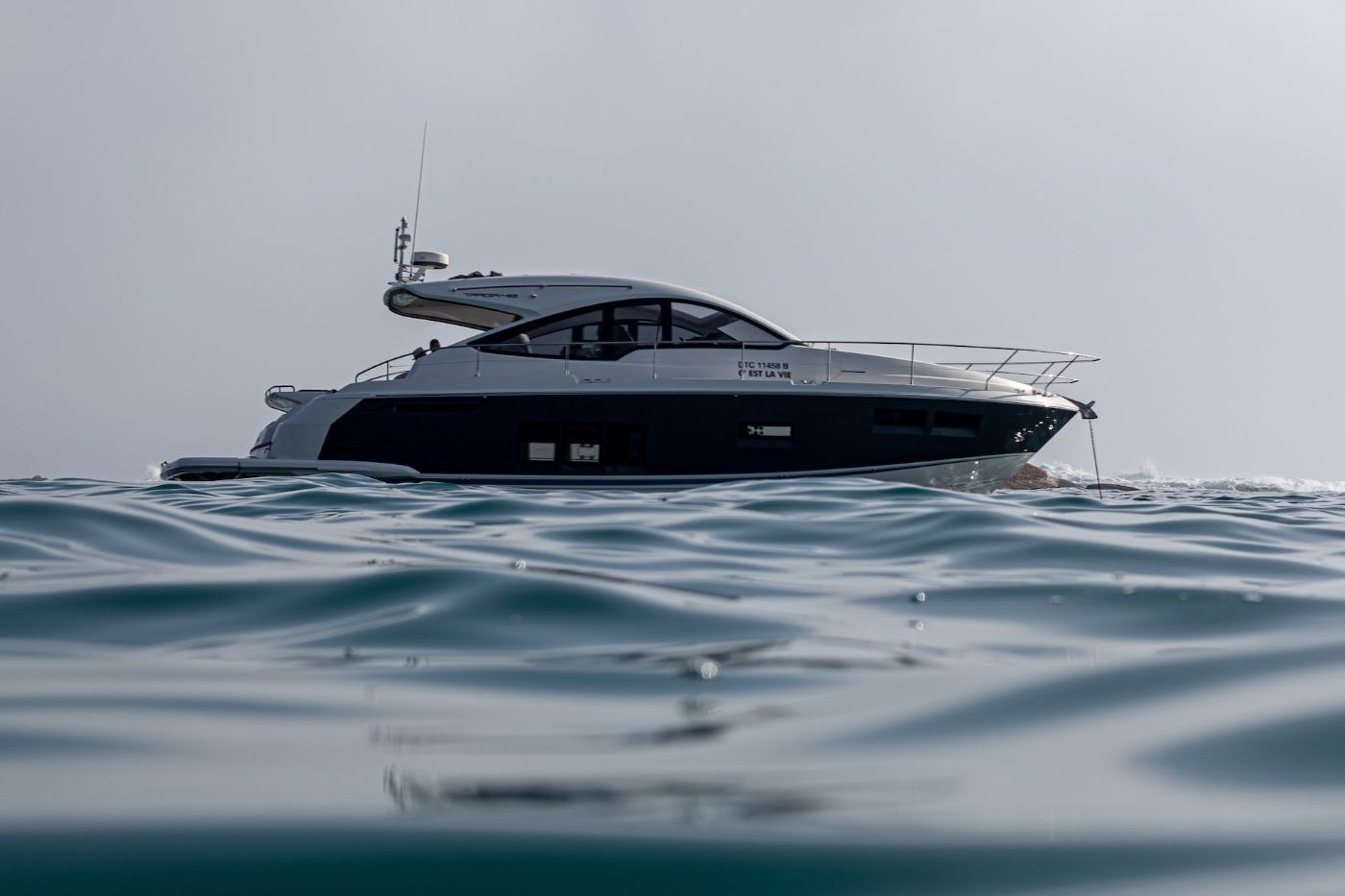
The type of yacht you own will determine the fuel you use. For example, a motor yacht will require more fuel than a sailing yacht. Fuel costs are usually calculated per gallon. You can use a yacht fuel cost calculator to estimate how much fuel you will need for your trip and the approximate cost.
You can save money on fuel costs by filling up at a marina that offers fuel at a lower price. You might also want to consider using fuel additives that can improve your yacht's fuel efficiency and reduce fuel consumption.
Leave a comment
You may also like, how much sailboats cost on average (380+ prices compared).
Turns out that owning a sailboat is pretty affordable. OK, it isn't cheap, but it can absolutely be done on a budget. In this article, I'll show you exactly what to …

Average Cost of Buying & Owning a Catamaran (With 4 Examples)

The Average Cost of Owning a Boat in Florida (4 Examples)

Average Sailboat Insurance Cost in 2023 (13 Examples)

How Much Does a Boat Cost in 2024? (With Ownership Costs)
Residents all across the US are buying more boats than ever before. From kayaks and canoes to the most luxurious and opulent yachts, manufacturers are struggling to keep up. But with so many potential buyers being first-timers, the question will inevitably come up, “roughly how much does a boat cost?”
How Much Does a Boat Cost?
What determines boat price, renting vs. buying a boat, cost of owning a boat, total cost of boat ownership.
An average 20’ boat used can often be found for between $10,000 and $20,000. The same boat bought new would likely be $40,000 to $60,000. One of the biggest factors that will impact the price is the style of the boat, with the length of the boat figuring heavily as well.
Buying used boats will always save you money getting the boat into your hands initially, but they will almost always cost more in maintenance and repairs during the term of ownership.
All boats, though, will require maintenance and additional costs associated with ownership. Below is a quick rundown of common boat types and what they can be found for new and used where applicable.
| Boat Type | Common uses | Size | Used Price | New Price | Popular Model |
| Bowrider boats | Watersports, cruising, fishing | Under 20’ | $10,000-$25,000 | $15,000-$30,000 | |
| Pontoon Boats | Leisure, fishing | 18’-25’ | $8,000-$12,000 | $19,000-$65,000 | |
| Fishing Boats | Fishing | 16’-25’ | $5,000-$10,000 | $30,000+ | |
| Cabin Cruisers | Cruising, leisure | 25’-45’ | $100,000 | $250,000+ | |
| Speedboats | Watersports | 20’-30’ | $20,000 | $30,000+ | |
| Cuddy Cabins | Cruising | 18’-28’ | $20,000-$30,000 | $50,000 | |
| Sailboats | Cruising, leisure | 30’-35’ | $20,000 | $80,000+ | |
| Yachts | Leisure, cruising | 30’-100’+ | $150,000 | $250,000+ |
There are several factors that will affect the cost of a boat. Firstly you will need to determine what type of boat you are buying after which it will be a choice between buying used or new. Each will have its own benefits and drawbacks, both short and long term.
The boat price range will also depend on the time of year during which you buy. The same boat, priced at off-season and during full-swing boating season, may have a price that differs by 5%-15%. This can mean a difference of thousands, depending on what type of boat is being shopped.
Other factors that influence the pricing for boats will be the age, the features, the condition, and whether it is being bought from a dealer or a private party. All other things being equal, a boat will generally be cheaper when bought from a private party than from any sort of dealer or marina.
Used vs. New Boats
Many first-time boat buyers find themselves wondering if they should buy a new boat or a used boat. There are several benefits as well as drawbacks for both. Depending on your time and resources, there may be a clear-cut best choice for you, or you may still have to do some thinking.
While the used boat market will definitely save you money initially, which can be incredibly powerful when shopping, you may ultimately find that the boat maintenance cost that you experience is more than initially expected.
This will fluctuate in accordance with the level of care that the previous owner or owners maintained. If you are more budget-conscious, however, a used boat may be best since you can save later by doing your own repairs.
If you have more money than time or patience, the new boat cost may not be that offputting, since it may ultimately mean less repair cost and shop time during the term of ownership. Bear in mind, however, that buying a new boat will not relieve you of routine maintenance like oil changes.
Size and Style
Just like with other vehicles, boats come in different sizes and styles , which affects the boat price. If you are looking for a fishing boat, expect to spend more than a canoe. If you really like the 24’ model over the 22’ model, understand that your sticker price will likely be higher for a base model.
Before you make any final decisions about the size and style of boat you are going to start shopping for, make sure you think hard about how it will be used in the future.
If you plan to take a lot of guests out, make sure you have the capacity for that. If you will only ever take out a maximum of 3 or 4 people, there’s no need to spend a robust sum on something that has 8 seats, when a medium-sized boat will suffice.
Always remember not to buy beyond your experience level. If you are a new boat owner, ideal boats are most likely going to be 15’ to 18’ in length and have a modest engine.
If you get a boat that you aren’t ready to operate in the hopes that you’ll “grow into it” you can be putting yourself in a dangerous situation. Bigger boats also mean increased boat mooring costs.
One of the things that will have the biggest impact on the price of a boat is the feature set that it is equipped with. Boats can have a surprising amount of features, upgrades, and tech gadgets that can add significantly to the cost.
Some of the features that affect the average boat price include cutting-edge chartplotters, built-in media systems, specialty (often LED) lighting, battery chargers and maintainers, swim or diving platforms, hydraulic steering , autopilot functionality, and GPS position holding.
Higher-end boats may even feature additional comfort or even luxury features that greatly increase the boat cost.
This can include things like joystick steering controls, vacuum head systems, custom flooring, countertops, or finishes, satellite weather systems, and even climate-controlled cockpits and cabins.
In many areas, particularly those that incorporate leisure watersports or sport fishing, rental boats may be available. This can be very convenient for those who do not own a boat and can allow you to get out on the water with only the most minimal investment in boat costs.
Some of the upsides to renting a boat include never having to worry about the costs of owning a boat or the time investment of maintenance that the boat will require. This is the perfect option for those who may only get out on the water a couple of times per year, and it removes the burden of off-season storage.
There are some downsides to renting, however. With rentals, don’t have to pay for the cost of boat ownership, but you may not be guaranteed to get the boat that you want, even with reservations. You also generally rent very basic boats that are limited in range and ability. Some rental locations also do not allow nighttime navigation, which can be restrictive.
Boating costs $1,000 to $6,000 in expenses yearly, on average. The costs of owning a boat don’t end with the price of the boat and the first tank of gas. There are significant costs associated with owning a boat, some are costs like taxes and registration that you would have on any vehicle, and some are going to be unique to boating.
If you don’t plan ahead for a lot of the boat ownership costs it can end up costing you more in the long run. Some of the additional things that many beginners don’t think about include:
- Boat fuel cost
- Marina costs
- Boat launch fees
- Seasonal maintenance
- Boat repair costs
- Seasonal storage
- Transportation, in the case of some larger boats
Boater education is incredibly important for the safety and enjoyment of your boating experience. Taking a formal boater education course ensures that you have the foundational knowledge needed to safely and effectively operate your boat. It can also save you a bit on your boat insurance.
Too many first-time boat owners assume that if they buy the boat and are exempt or not required to have a license, that they can just go out and boat.
Many states do not require boater education, but there are also many that do, and if you test and get certified by a NASBLA body, you can use the certificate anywhere.
Requirement : Essential for safe operation Frequency : One time Cost : <$100-$500
Just like your other vehicles, you’ll need to register or license your boat . The fees and process will vary greatly by state, but the fees range from around $20 up to over $200. They will often be determined by the type of vessel and its length, as well as the length of time that the boat is registered for.
Once registered, you will receive some type of registration proof to keep with your vessel. You will also be assigned a registration number that you will need to affix to the bow of your boat with reflective stickers.
Requirement : Required for all powered boats Frequency : Varies by location, from yearly up to lifetime Cost : $20 to $200
Just like everything else in life you will need to pay taxes on your boat. The severity of this tax obligation will depend heavily on where you live. The feds won’t take a cut, but you will need to pay the state as well as any local taxes owed.
The sales tax will only be paid once, and that will happen at the point of sale. The other types of tax that may apply are a use tax, if you somehow avoided paying sales tax, this will be paid to the jurisdiction where the boat is most often used. The personal property tax is the one that will hit you every year, just like any other vehicle.
Requirement : Mandatory for all boats Frequency : Yearly Cost : Varies by location
Maintenance Cost
All boats will need maintenance , which should be expected as part of the cost of owning a boat, regardless of the size or type. However, maintenance costs are one of the costs that can be largely avoided by renting.
If you own your own boat, you will need to plan for maintenance items to be taken care of before and after each outing, some maintenance that will only need to be done a few times per year if you are really active boaters, and some maintenance that is only going to be needed on a seasonal basis.
You will need fresh water flushes, oil changes, steering system inspections and maintenance, deck and seat cleaning and maintenance, hull inspections, propeller inspection and replacement, potential anchor replacement, and more.
Good operation and preventative measures can minimize abnormal maintenance costs.
Requirement : Required on all boats Frequency : Routine and seasonal Cost : $1,000-$6,000
Fuel cost is something that can creep up on you if you don’t stay aware of your boat’s fuel situation. Operating a boat uses fuel, just like any other vehicle. The fuel cost for your boat will be measured in a similar fashion to your car or truck.
Some small, single-person boats can keep an angler on the water all day on just 1-2 gallons of gas or less. Small rental fishing boats may have a 5-gallon tank which is more than enough for them, while the same amount of gas in a boat meant for towing waterskiers or tubes will burn that gas much faster.
Estimate your fuel cost ahead of time by making sure that you are familiar with the consumption rate of your boat. You can also save gas by keeping the revs lower and learning how to properly adjust your trim. Fuel costs may be included in your monthly marina cost as well if you lease space with one.
Requirement : Required in all powered boats Frequency : As needed Cost : Current gasoline market value, plus oil depending on the engine
Boat Trailer and Tow Vehicle
When you own a boat, unless it’s a relatively large boat that cannot be transported personally, you will need a vehicle to tow it and a trailer to put it on. These are essential for nearly all boat owners, though many will not buy a boat if they have to way to move it.
Your trailer must be capable of carrying the weight of the boat and any other cargo on the boat at the time of loading. Trailers must also be frequently inspected to ensure safety and functionality, and in most states, your trailer must be registered just as any vehicle, which can be its own annual expense.
Requirement : Required for all powered boats Frequency : Once Cost : Varies, some boats include, otherwise avg. $3,000
Requirement : Requirement Frequency : Once Cost : N/A
Boat Insurance
When you own a boat you need to protect it, and that means taking out an insurance policy on it. This ensures that if something were to happen to the craft that it would be covered. It is generally illegal to operate a boat without current insurance on it.
Getting insurance on a boat can be a relatively cheap task, particularly if you’ve taken the time to finish a boater safety course and obtain your safety certificate. Most insurance policies for boats will only cost between $20 and $50 per month for average vessels.
Insurance is also vital protection in the event that someone else is injured on your boat. Without insurance, you could face personal liability in the event that something were to happen while passengers were aboard.
Requirement : Required Frequency : Monthly/Quarterly/Yearly Cost : $20-$50 per month
Winter Storage
In most areas, the boating season is only so long and when the weather starts to get cooler it’s often seen as the time to get the boat ready for storage. In many cases with smaller boats, they can be easily over-wintered in the owner’s garage if proper precautions are taken.
Boat owners can also rent an off-season storage space in a facility that will keep them secure and tended. Boats have batteries that must be maintained with charging, and unattended boats are the perfect place for pests and vermin to start to gather.
Having someone manage that for you can take a lot of stress and clutter out of your garage or storage unit. Indoor storage is often more than $50 per square foot of space needed, while outdoor storage can run about half of that.
Requirement : Required in all but equatorial regions Frequency : Yearly Cost : $525-$200 per square foot
Mooring and Marina Fees
This is essential for those who live in areas where you will be boating often and will not want to trailer your boat from storage to the launch each time. If there is a marina nearby, you can often rent or lease a boat slip to park your boat in during the season.
They frequently charge by the size of the boat and the amenities requested, like charging or freshwater supply. Not only do they allow you to keep your boat ready to go out at a moment’s notice, but they often are well-secured and safer than other storage locations.
Requirement : Optional Frequency : Monthly/Yearly Cost : $50-$1,000 per month
Equipment and Accessories
When planning to buy a boat, safety gear should always be considered part of the overall purchase cost.
Paddles, life jackets, signal flares, a horn, and many other things are important to have onboard before you hit the water in your boat for the first time.
In fact, there are some items that are required for you to have at all times.
Required safety equipment:
- Fire extinguishers
- Life jackets and wearable personal floatation devices
- Throwable flotation devices
- Visual signaling devices
- Sound signaling devices
Additional accessories, like lighting, watersports equipment, and stereos are a fun addition to your boating experience, although they aren’t required. If your equipment budget is limited for now, you can always purchase the necessities and add exciting upgrades as you are able to.
Requirement : Some safety equipment is required Frequency : As needed Cost : $500
As you can see, there is a lot more to boat ownership than just buying a boat. The first-time boat buyer, buying a new boat with a trailer for a modest $15,000, and towing it with their existing vehicle, can still expect to spend more than an additional $5,400 the first year alone, expecting minimal maintenance on a new boat.
Buying a used boat may save you on the initial purchase price, but depending on how the last owner treated her you may be in for a lot of shop time.
If you are not a first-time boat owner and you’re looking to try and estimate your yearly ownership costs on a bigger, more expensive boat, there are a few ways you can ballpark that estimate. The most popular is a yearly cost of ten percent of the purchase price, before adding in seasonal storage, which can easily double that number.
Boat price: $15,000 Education: $100 Licenses: $100 Taxes: $30 Maintenance: $1,500 Fuel: $200 Trailer: $0 Towing vehicle: $0 Insurance: $300 Winter storage: $2,500 Mooring: $240 Equipment: $500
How much does a boat cost per month?
If your annual boat maintenance costs you $2,400, for example, that would make your monthly burden about $500.
How much does a boat cost to rent?
You can frequently rent a simple fishing boat for around $400 per 8 hour day, while a pontoon boat may run twice as much, plus fuel.
How much does it cost to dock a boat?
If you rent a boat slip from a marina, you can expect to pay between $100 and $1,000 per month, depending on your boat.
How much does it cost to maintain a boat?
Your maintenance costs will vary depending on boat use, but it will be a significant portion of the yearly cost of ownership.
How much does it cost to own a boat?
The average cost of boat ownership for most fishing or pleasure crafts will be between $1,000 and $6,000 per year.
How much does it cost to own a yacht?
Plan on a yearly cost of around 10% of the value of the boat, so a $10 million dollar yacht will cost about one million per year.
How much does a used boat cost?
Some used boats can be on your trailer heading home with you for a couple of hundred bucks, some others a couple of thousand.
How much does a big boat cost?
Some of the biggest private boats, like large yachts, can cost more than $1,000,000 for every foot of total boat length.
How much does a small boat cost?
Small boats, like jon boats or small bass boats, may only cost a few hundred if bought used on the private market.
How much does a new boat cost?
This will depend greatly on what type of boat you want and what it’s going to be for, the basic boats start around $1,000.
How much does a riverboat cost?
Depending on what you’re looking for in your riverboat you may be able to pay as little as $12,000, though they do go for $40,000 or more in some cases.
How much does a speed boat cost?
A speedboat can frequently be found used for around $30,000 without a cabin. Larger or more powerful boats may have a cockpit.
How much does a motorboat cost?
A run-of-the-mill motorboat will cost you, on average, between $10,000 and $20,000 with more extravagant models going for much more.
How much does a cabin cruiser cost?
The average mid-range cabin cruisers will cost about $250,000 and budget models at about half that amount.
How much does a fishing boat cost?
Fishing boats can commonly be found for around $10,000, increasing significantly with features and options.
How much does a ski boat cost?
The average ski boat will set you back about $150,000, for a common and relatively basic model with average features.
How much does a sailboat cost?
Sailboats range quite a bit in their price, being found on the used market for $20,000 while new ones can cost $80,000 or more.
How much does a yacht cost?
Some basic yachts can be found for $250,000, though most new luxury yachts will cost up to $1 million per foot in length.
How much does a bass boat cost?
Bass boats can range in cost greatly, from budget models starting around $10,000 to high-end tournament fishing boats for $70,000.
How much does a bay boat cost?
If you are looking for a bay boat, you can reasonably expect to pay at least $10,000 for a relatively capable craft.
How much does a bowrider cost?
Some of the more basic bowrider boats will cost $15,000 new, with longer boats or more feature-dense crafts reaching $50,000 or more.
How much does a center console boat cost?
Used center console boats are available on the private market for around $10,000, while premium models and features can cost tens of thousands more.
How much does a convertible boat cost?
New convertible boats can be obtained for as little as $14,000-$15,000, while some models and options packages will push the price well over $50,000.
How much does a power cruiser cost?
The market for power cruisers isn’t cheapest by any means, and a new power cruiser will often be around $100,000 for a relatively basic vessel.
How much does a cuddy cabin cost?
Even the most basic cuddy cabin bought new will cost around $50,000, with options and features boosting the price from there.
How much does a deck boat cost?
Buying a new deck boat will cost you at least $20,000 for basic models, with more powerful or extravagant models pushing $60,000 and more.
How much does a flat boat cost?
Most flats boats can be found for around $25,000-$30,000 from major names, with some being under $10,000.
How much does a high-performance powerboat cost?
New performance powerboats have an average price of around $80,000, however, the average used boat prices are far lower and hover around $30,000.
How much does a house boat cost?
The average cost of a houseboat is usually around $50,000, but you should double-check the marina policies to ensure houseboats don’t incur larger docking costs.
How much does an inflatable boat cost?
For more robust inflatable boats, the average cost is going to be about $1,000, with a range of a few hundred dollars to either side, usually.
How much does a jon boat cost?
If you like cheap boats, a jon boat is perfect and you can usually buy one used for around $500, with brand new boats going for around $1,000 or more.
How much does a pontoon boat cost?
If you are looking for brand new boats, the average boat cost for a pontoon boat will be between $18,000 and $50,000 in most cases.
How much does a catamaran cost?
If you’re looking for a catamaran the average cost of a boat that has been used is around $35,000, and upwards of a million for more serious crafts bought new.
How much does a runabout boat cost?
Runabout boats are incredibly popular and they can start at around $12,000 for a basic starter and up to $80,000 for more opulent crafts.
How much does a trawler boat cost?
Lots of people considering buying a new boat are looking into trawler-type boats and even used they can cost around $13,000.
How much does a walkaround boat cost?
If you are in the market for a walkaround boat, you can plan to spend about $8,000 for a used one on the open market.

Robert Owens is the Chief of Content of Quicknav. Robert has been boating for over ten years and loves to share his experience on the water. His first boat was a dirt-cheap moderately beat up 2003 Bayliner 175, where he learned a tremendous amount about trailering, launching, docking, operating, and maintaining. He currently owns a Cruiser Yacht and is eyeing a sailboat.
Similar Posts
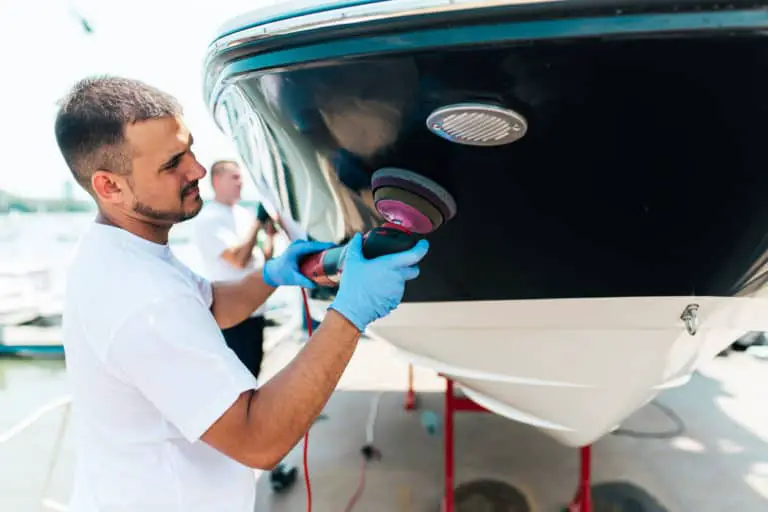
Boat Maintenance: The Definitive Guide (2024)
Many new boat owners are a little intimidated by the thought of the boat maintenance that they need to do….

How to Get a Marine Radio Operator Permit in 2024?
Obtaining your marine radio operator permit from the FCC is only a necessity under certain circumstances (1), but they allow…
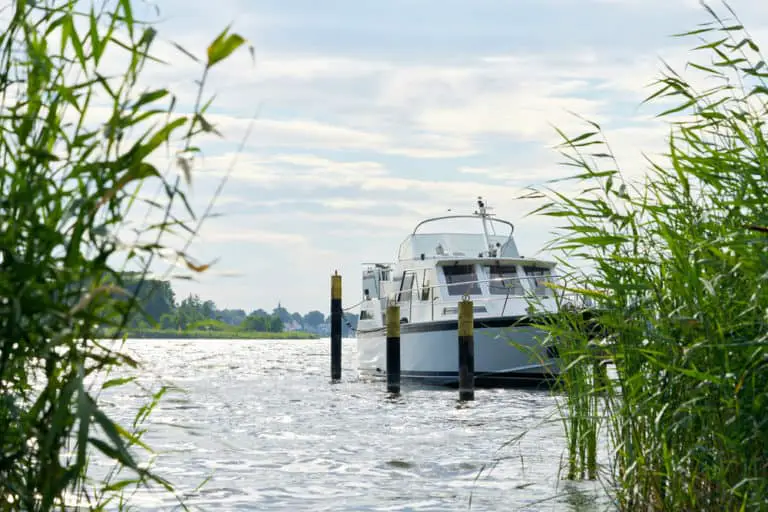
Do You Need a License to Drive a Boat in 2024? (U.S. & Canada)
It’s getting to be prime vacationing time, and if you’re traveling to enjoy some time on the water, you will…
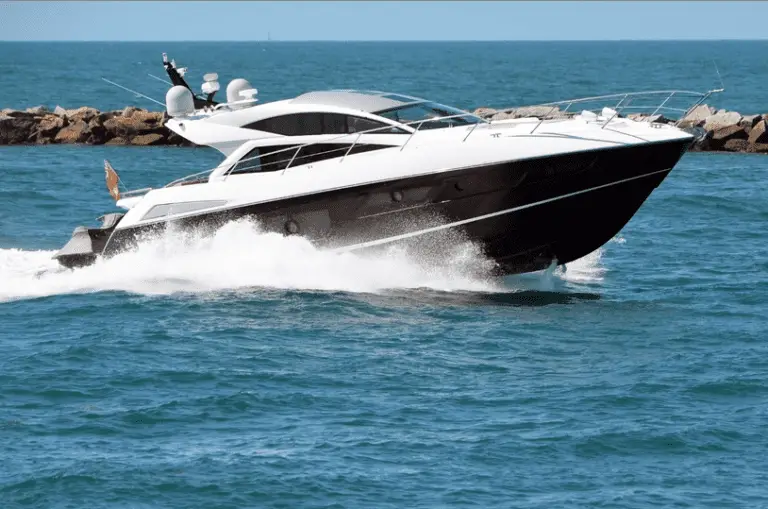
Cabin Cruiser: The Ultimate Guide (2024)
Passengers: Maximum 10Length: 20-40 FeetTrailerable: YesBest for: Day Cruising & Overnight TripsPrice Range: $100,000-$500,000Propulsion: 2+ Outboard Engines Many boaters want…
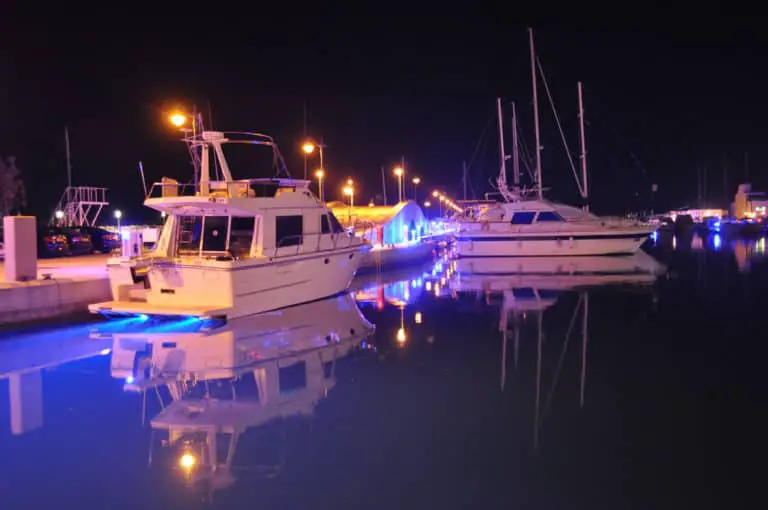
15 Tips for Boating at Night [for Safety & Navigation]
As a new boat owner, one of the activities you may be most excited about is your opportunity to experience…
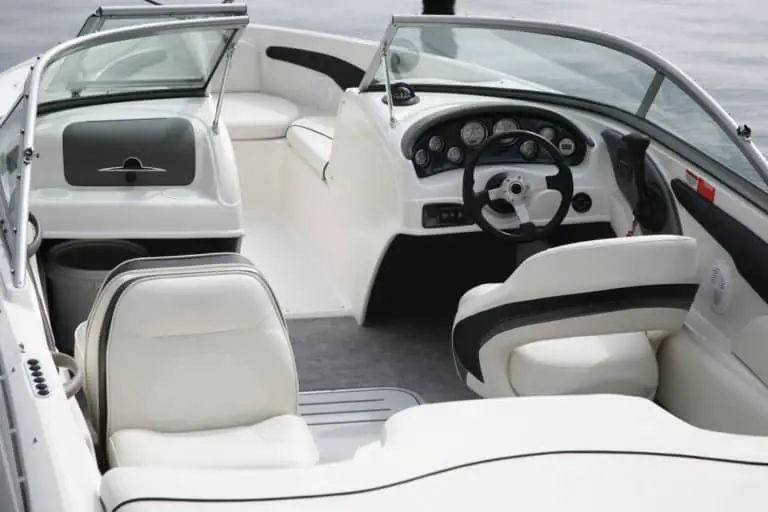
How to Clean Boat Seats? (a Practical Guide)
So you’ve bought your first boat and while you think you can master most of it with ease, you keep…

IMAGES
COMMENTS
Nov 8, 2023 · 40 Foot Yacht Cost. A 40-foot yacht can be found used for around $200,000 and new models can cost as much as a million dollars. There are always lots of used yachts for sale around 40 feet in length, which makes them more attractive to first-time buyers. Technically, a yacht begins at 23 feet.
Used Boats For Sale – 30-39. Explore used boats and yachts for sale worldwide between 30-39 feet. 30-foot boats are great for, but not limited to, families and couples looking to cruise the waterways in complete relaxation or anglers who enjoy inshore and offshore fishing.
Buying a boat is another broad term, where everything from a Jon boat to a pontoon boat to a 30-foot cabin cruiser can fall within this category. If we take a 20-foot bowrider, for example, we can see how the cost of buying a boat can vary hugely from around $25,000 to $150,000.
Find Catalina 30 boats for sale in your area & across the world on YachtWorld. Offering the best selection of Catalina boats to choose from.
The cost of a new 30-foot motor yacht can range from around $100,000 to over $500,000, with some luxury models costing even more. Although operating a motor yacht requires less skill and experience than operating a sailing yacht, the initial purchase price and ongoing costs are higher than that of a sailing yacht.
Jan 17, 2024 · 20’-30’ $20,000: $30,000+ ... Some basic yachts can be found for $250,000, though most new luxury yachts will cost up to $1 million per foot in length.